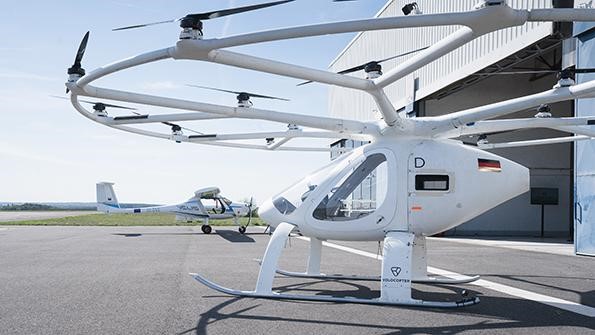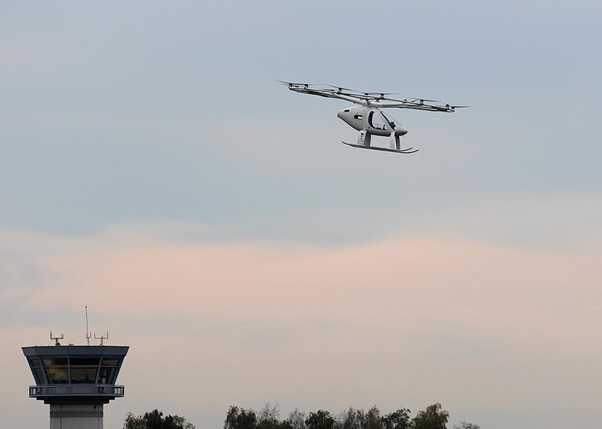
Programmes
AeroForum
Home >
Top Reads >
Demonstrations highlight operational challenges for AAM
Demonstrations highlight operational challenges for AAM
Demonstrations highlight operational challenges for AAM
INDUSTRY 360° | 20 OCTOBER 2022

Volocopter | Volocopter’s remotely piloted 2X prototype (foreground) took part in collaborative flights with a crewed Pipistrel Velis Electro (background) during the CORUS-XUAM demonstrations at Pontoise.
If the promise of advanced air mobility is to be realized, much more has to happen than aircraft achieving type certification and being manufactured in quantities sufficient to make commercial operations viable.
While electric vertical-takeoff-and-landing (eVTOL) vehicles can be flown into and out of conventional airports, the benefits the new sector offers will require new kinds of operating locations. And management of a more crowded, more dynamic airspace will need to ramp up to accommodate large numbers of new aircraft and routes. As a result, advanced air mobility (AAM) aircraft manufacturers, unlike their peers in traditional aviation, will need to be involved in the design, construction and, perhaps, operation of airports and airspace.
“If you just concentrate on the aircraft, you won’t make the aircraft fly,” Jorn Jaeger, Volocopter’s head of airspace and vertiports, told Aviation Week after demonstration flights from Pontoise Aerodrome, near Paris. “We need to solve the other issues. At Volocopter, we see it as an ecosystem. We have to play all the different instruments and orchestrate it from our perspective.”
Jaeger spoke following a collaborative program of demonstration flights in which the company helped develop a number of airspace-related operational concepts to integrate AAM and drones alongside conventional air traffic. The work, conducted as part of the European Union-funded CORUS-XUAM project, focused on developing procedures for emergency situations.
“I think specifically what we demonstrated here is the collaboration between [air traffic control (ATC)] and the [uncrewed traffic management (UTM)] system,” Jaeger said. “We had normal situations already tested in our normal operations, but here we went one step further and had these non-nominal situations so that we [could] see what happens if something unexpected [occurs]. Many aircraft intervene with what we have to do, so how would the systems react? How is ATC reacting? How are the pilots, be they in the air or on the ground, informed? How is that conflict solved?”
The scenarios run during the CORUS-XUAM demonstration were complex and challenging but were of necessity limited. Although Pontoise is a functioning airfield, traffic is light and the airspace relatively uncluttered. It is in a rural location with no nearby buildings taller than the airport tower. And each scenario was planned for weeks in advance, with every participant aware beforehand of the precise nature of the simulated emergency. Still, Jaeger asserted, the lessons learned will be applicable to the inevitably far more complex and unpredictable urban operations that will come.
“These are first steps, and it has to go in this direction,” he said. “Today, we have very clear responsibilities certified in the airspace: There’s the pilot, there’s ATC, and there’s really nobody else. We have to define other roles.”
These questions—vital to the development of the AAM sector—are arguably more pressing for Volocopter and its partners in France than for other AAM developers. The company has committed to providing a commercial air taxi service in Paris during the 2024 Olympic Games.
The work at Pontoise—in collaboration with entities including Groupe ADP, which operates a number of Paris airports; French aviation regulator DGAC; and RATP, the state-owned public transport provider for the Paris region—is being conducted with one eye on that deadline. And while airspace issues will be critical, the nature and location of where the company’s VoloCity aircraft will fly to and from will be just as important.
“We definitely have a list” of potential operating sites in Paris for 2024, Jaeger said. “We are still in the finalization process to refine it, with several stakeholders involved.”
The locations will, to an extent, determine some of the parameters for airspace design. Using existing heliports and the routes between them is one option and would likely prove the least challenging path to enabling operations quickly—but in the longer term, the idea holds less appeal. If eVTOLs become perceived as merely zero-carbon helicopters, the potential benefits of accessing different operating locations and getting passengers closer to their final destinations will not be realized.
Volocopter wants to “make use of the performance that our aircraft has,” Jaeger said. “It’s different to a helicopter, and we have to tell the authorities what the differences and limitations are. [Using heliports exclusively] is exactly what you want to avoid.”
Although it has collaborated with vertiport developer Skyports on a feasibility study in Malaysia, Volocopter has also been developing its own vertiport design. “We started as a company to create an aircraft,” Jaeger said. “But we have learned, meanwhile, we have the fourth generation of aircraft. We understand pretty well our aircraft and the performance of our aircraft, and this drives the need to think about the vertiport—because we have hardly seen anybody around us being able to design a vertiport according to our needs.”
A prototype VoloPort was built with Skyports in Singapore in 2019. Last December, Volocopter published a handbook intended to give current and future vertiport partners a detailed understanding of what requirements a VoloCity aircraft will have, both in terms of operational infrastructure and providing a high-quality and appropriate passenger experience.
“We’re in collaboration with our partners; we can’t do everything on our own,” Jaeger said. “Our principle is form follows function. We need to understand how the aircraft works, what is the concept of operation, and then we design a vertiport around it. I think our partners understand this now. It’s in our interests that they can do it, but we have to develop the concept.”
The end result is, in effect, an airframer being a design authority for airports. And though the aspiration is not necessarily to manufacture, own and operate the infrastructure, Volocopter’s position appears to be that the company needs to be ready and able to do that in the event that third parties cannot provide what it requires to conduct operations.

Angus Batey/AW&ST | Volocopter’s 2X prototype flew remotely piloted during the Pontoise demonstration flights.
In turn, this also means that any concept Volocopter comes up with for a vertiport should be able to accommodate other manufacturers’ vehicles. Jaeger contended that the VoloCity design—which uses skids rather than wheels and thus raises challenges for ground maneuvering, and which relies on swappable batteries charged in cabinets rather than plugging the aircraft in to charge—means that if a vertiport can accommodate a Volocopter aircraft, it ought to be easy for other manufacturers’ vehicles to use it.
“When will we really see the first time different aircraft models are using a small vertiport in a city? I think that’s still some time out. But we need to have something ready,” Jaeger said. “We don’t have to own the assets—that’s not the policy of Volocopter. But if there’s a vertiport that started as a VoloPort, I think we’re perfectly fine to accommodate the needs of other aircraft.
“Our concept is to keep the complexity out of the aircraft, move quickly with certification and maybe have a bit more complexity on the ground,” he added. “With ground moving equipment and battery-swap charging I think we have done most of it. A quick-charging opportunity for another aircraft is not a big challenge, while the other way around is more challenging.”
The work the company is doing to prepare for the 2024 Olympics will have wider applicability as Volocopter looks to develop operations in other cities, Jaeger pointed out.
“The high-level topics are international—it’s [the International Civil Aviation Organization] or it’s European,” he said. “ [The European Union Aviation Safety Agency’s] working group on Rulemaking Task 0230 looks at all the aspects that come with VTOL operations, and one is addressing ATM. I’m on that working group for exactly that reason—to see what is needed and has to be changed on a European level. At the moment, that’s in the comment phase. If and when it’s adopted, that will apply everywhere in Europe but the UK, probably.”
Nevertheless, there will be some elements of AAM operations that will be determined by cities rather than at the national or international level. And different entities will seek a seat at the table when decisions are made.
“New stakeholders are now involved that haven’t been involved in the past with aviation,” Jaeger said. “Like cities, security agencies, police. If they say this is an area where we don’t want to have anybody, then that’s it, you know? With normal aviation the police have no say. So in this sense, that is new.”
By: Angus Batey
This article was first published in Aviation Week & Space Technology.
Stay current with Aviation Week Network’s latest news, analysis and insights impacting the global aviation community.
Sign up for one or more of their sector-specific digests.
